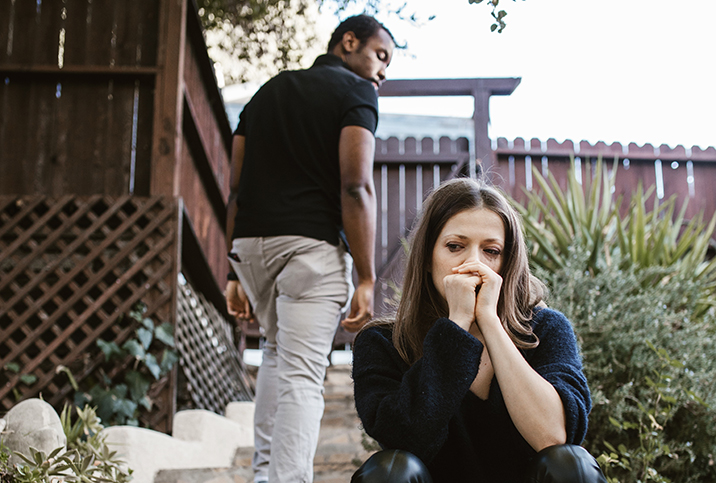The Silent Treatment Is Even Worse for Relationships Than You Think

Shunning, stonewalling, the silent treatment. Whatever you want to call it, avoidance in communication is a manipulative and strategic tactic intended to frustrate and alienate the recipient. The person receiving the silent treatment might begin to question whether the sender is upset, why they're upset and begin trying to interpret messages in behavior.
Sound familiar?
Gaslighting is a form of psychological manipulation used to cause doubt in an individual. Tactics include the withholding of information and diverting attention, all with the intention of increasing personal control and power in a relationship.
Like gaslighting, the silent treatment is used to change another person's behaviors and thought process by means other than direct discussion and constructive argument.
Disagreement is inevitable within platonic and romantic relationships, even healthy ones, but being upset does not need to translate to conflict. Actively attending and communicating in relationships increases relational well-being, empathetic listening and collaborating to solve problems.
Behaviors associated with the silent treatment
Evolutionary psychology indicates that a sense of belonging and feelings of connection are primary human needs that directly affect self-perception, self-esteem, control and meaningfulness. The act of ostracism—or being ignored or excluded from the group—has been used throughout history to motivate society to obey social norms and change behaviors.
"The silent treatment is a learned behavior," said Nadine Macaluso, Ph.D., a somatic therapist and expert in PTSD. "Human brains and bodies are physiologically wired to communicate and connect with others."
Naturally, humans began to integrate social pain into survival by avoiding the negative emotional states evoked by exclusion. Over time, humans have also developed the ability to detect cues of ostracism. Where once this meant things like lack of eye contact, body language markers, gestures or physical distance, humans now can pick up on cues like having their messages ignored in texts or receiving no social media interactions from a given person.
Aside from evolutionary reasoning, Aliza Shapiro, L.C.S.W., a licensed psychotherapist in New York, agrees with the hypothesis that the silent treatment is still taught and learned.
'The silent treatment is a learned behavior. Human brains and bodies are physiologically wired to communicate and connect with others.'
"Like many of our relationship behavior patterns, the silent treatment is commonly learned from important childhood figures or past partners," Shapiro explained. "Whether individuals have suffered from emotional neglect, persistent invalidation or the silent treatment itself, it can make skillful communication as adults much more difficult."
For children and young adults, observing and engaging in unhealthy patterns of conflict avoidance in close relationships, especially parent-child ones, results in maintaining and continuing learned behavioral patterns. And the first step to overcoming them is to notice they're happening at all.
"Like all childhood wounds, recognizing them does not absolve us of the responsibility to change—it ignites it," Shapiro noted.
The connection between the silent treatment and gaslighting
The silent treatment is strikingly similar to gaslighting, as both flourish in power and control. In fact, some therapists call the silent treatment a form of gaslighting, used to cause personal uncertainty, and a sense of doubt when considering goals, self-views and worldviews.
"Emotionally abusive individuals can say or do something to make another feel something—happy, sad, upset, guilty—to feel in control of the emotions of others," said Heidi Brocke, a toxic relationship awareness and healing specialist. "By not interacting, the victim will feel rejected, alone and unworthy. These feelings lead the victim to try everything they can to gain the acceptance of the toxic person."
Like gaslighting, the end goal of the silent treatment is to punish the recipient by blocking or withdrawing information to gain control. The motives of gaslighting are consistent with power and control struggles. By undermining the recipient's thought process, judgment and behavior, manipulation allows the perpetrator to maintain power and repeat the cycle.
"It's more than avoiding conversation," Brocke added. "There are times when being silent is better for your safety. However, when used to get something or take advantage of another person, it is a toxic trait."
The psychological effect
A study by Kipling D. Williams, a Purdue professor of psychological sciences, indicated the neurological and psychological effects of the silent treatment. Williams' research found that ostracizing leads to registered physical pain and social injury through the brain's dorsal anterior cingulate cortex. When ostracism becomes chronic, psychological effects include isolation, helplessness, depression, low self-worth and aggressive behavior.
Unsurprisingly, in this light, after receiving the silent treatment, regaining a sense of control may be difficult for individuals, even in future relationships.
"When someone is rejected, they will do all they can to regain approval, even if it means sacrificing their values and beliefs to do so," Brocke said. "Many find it difficult to make decisions, even small ones, after living in an unhealthy environment for a time."
For the perpetrator, the demand for change from the recipient causes a "demand-withdrawal" pattern. As the silent treatment becomes more common, the unsatisfied party in the relationship could withdraw completely.
As a result, the silent treatment damages a relationship by decreasing relationship satisfaction, trust and meaningfulness for all individuals involved.
Communicating during the silent treatment
The recipient of the silent treatment might be reluctant to communicate with the perpetrator due to previous attempts and subsequent rejection. However, the importance of self-expression through communication regardless of a response should be stressed.
"Express how the silent treatment hurts and leaves you feeling frustrated and alone, which isn't what you want or need in a relationship," Macaluso explained. "Emphasize that you can't resolve issues this way, and if this sort of behavior is a relationship deal-breaker for you, state it plainly."
For individuals who have learned the silent treatment as a form of communication, it's important to relearn expressing yourself directly.
"Use an 'I statement' as often as possible and communicate (a) what happened that hurt you, (b) how you feel about it and (c) what you need for it to be repaired. You might feel incredibly uncomfortable doing so, yet learning to tolerate that discomfort is part of the process of growing and healing," Macaluso advised.
If you or someone you know is in an abusive relationship, please visit the National Domestic Violence Hotline for more resources.


















